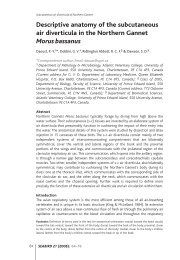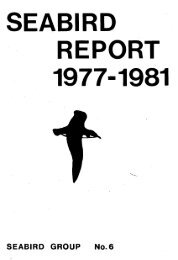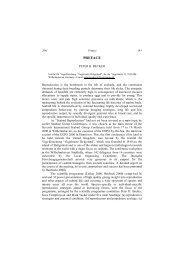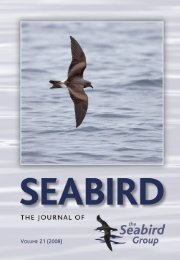Vol 6 No. 2 - The Seabird Group
Vol 6 No. 2 - The Seabird Group
Vol 6 No. 2 - The Seabird Group
You also want an ePaper? Increase the reach of your titles
YUMPU automatically turns print PDFs into web optimized ePapers that Google loves.
2004 Diet of Mediterranean Gull 75<br />
away off the nesting colonies (Burger & Gochfeld 1996) and flew up to 40 km<br />
away from Atanasovsko Lake. <strong>The</strong>refore, this study cannot correlate diet with<br />
foraging from specific fields under these crops. An opportunistic diet consisting<br />
of seeds, seasonally accessible and widely available, is confirmed by the<br />
significant increase in the number of pellets with Sunflower seeds after the start<br />
of sunflower harvest in mid-August, and with seeds of cultivated grapes in the<br />
same period. Pellets with Sunflower seeds were rare before mid-August.<br />
According to Hoogendoorn (1995), Sunflower seeds were probably pecked<br />
directly from the combs, a much more difficult operation than picking them up<br />
among stubble.<br />
Despite the prevalence of seeds in the diet, seeds are not the preferred<br />
food component of the gulls (Burger & Gochfeld 1996). <strong>The</strong>ir digestive systems<br />
are not well suited for digesting seeds and the predominant Barley seeds were<br />
not visibly damaged in 22% of the pellets containing them. Probably the<br />
glumes, retained only in the Barley seeds, have higher silica content than<br />
glumes of the other three most frequently occurring seeds (Georgiev &<br />
Tschakalova 2000). Irrespective of the intake of gastroliths to make seeds more<br />
digestible, some pellets with a large number of gastroliths still had intact seeds.<br />
At the same time, a small number of pellets without gastroliths had welldigested<br />
barley and wheat seeds. Apparently, not only the quantitative<br />
proportion of the swallowed seeds and gastroliths, but the length of their<br />
processing in the stomach is important for their digestion. Pellets with<br />
undigested seeds is not unusual, and this evidence indirectly corroborates the<br />
assumption of Goutner (1994) that the death of young gulls is linked to their<br />
stomachs being full of Wheat seeds. Regurgitation of intact seeds was<br />
confirmed by the germination of seeds of seven plant species, testifying to the<br />
role of the Mediterranean Gull in ornithochory.<br />
Animals supplemented the principally plant diet. Terrestrial animals<br />
predominated and appeared to be collected at random. <strong>No</strong> significant<br />
preferences appeared among major taxonomic groups. Dominance of<br />
grasshoppers and ground beetles among the insects and significant differences<br />
in the occurrence of invertebrates corroborate opportunism in food collection<br />
already verified by Isenmann (1975), Goutner (1986), Ardamatskaya et al.<br />
(1988), Zubakin (1988) and Meininger et al. (1991). Single pellets with<br />
predominantly animal remains reflect use of locally most numerous species.<br />
Fishes were mostly benthic species and, considering the ability of<br />
Mediterranean Gulls to fish (Cramp & Simmons 1983), they were probably<br />
gleaned as refuse from the fishing with dragnets in the Bourgas Bay.<br />
Ardamatskaya et al. (1988) have also established prevalence of pipefish and<br />
gobies in the fish diet of the gulls in the Ukraine, but during their breeding<br />
period.








